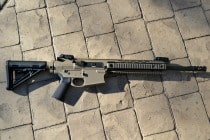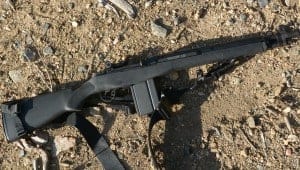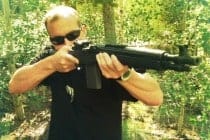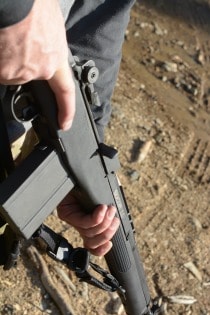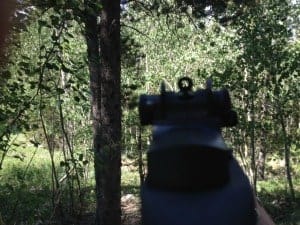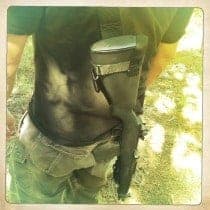If you grew up shooting rifles, then you might have an itch that a carbine just can’t scratch. Like many, I have always been a fan of the M-14 rifle, also known as the M1A, but I am a little too young to appreciate its predecessor, the M1 Garand.
SKIP AHEAD
The Scout Rifle
I grew up in the carbine/glock generation. You show me an M1 Garand or a Mosin-Nagant rifle and I will tell you that you have a musket, not a rifle. Sorry, I am just not into those WWI and WWII era rifles. I appreciated them but they are just not my thing. I grew up shooting bolt action rifles and pump-action shotguns in Texas hill country but I always longed for a carbine with low recoil and a high capacity magazine.
Like many people in America, I went through my AR-15 stages madness.
1. Had to have one
2. Had to rail it out
3. Had to attach stuff to it
4. Had to strip it back down and get back to basics
Sometime in mid-2006, I was in a gun store in Milwaukee, Wisconsin (Badger Guns) and saw the Springfield Armory SOCOM 16 for the first time. I looked at it with confusion. “What is that thing? It looks like a short M1A.” I remember the employee who helped me explain the rifle, M1A with a 16 inch barrel, top rail forward mounted for a long eye relief scope. This was right out of Jeff Cooper’s vision for a modern scout rifle. Jeff would have preferred the bolt action for a scout rifle but I have a feeling the gas operated SOCOM 16 with the 20 round magazine firing the devastating .308 round down range could have won him over.
I remember the first time I handled the SOCOM 16; I was in love with the feel. It had all of the characteristics of a rifle that I was use to from my days in West Texas along with some key carbine characteristics of a shorter barrel and high capacity magazines. All of this on a proven war tested platform of the legendary M1A rifle. I started making trips to different gun stores, holding the SOCOM 16 and admiring its feel and handling, debating with myself whether or not I should buy one.
Unbelievably, I did not purchase the Springfield Armory SOCOM 16 back then. There was the cost issue, at $1800 the SOCOM 16 was a little out of my budget. The other issue was that I had committed to the AR-15/5.56mm platform and as a dedicated Survivalist, it didn’t make sense to me to buy a rifle which would require me to stock pile different ammunition. Around the same time I remember seeing the Springfield Armory SOCOM II. I remember handling both rifles and I kept coming back to the SOCOM 16. I kept thinking to myself, this SOCOM II is the new version with all of the fancy rails but it doesn’t feel quite right to me. I was a SOCOM 16 guy; I liked the clean version of the rifle.
I never forgot about the SOCOM 16 but other things came up and it was put on the back burner and I never did acquire one. Back in 2012, I was out shooting with one of my friends, Andy Bell, who owns OD Green Supply in Arvada, Colorado. If you ever have a chance to shoot with a person who owns a gun store, I highly recommend it. Andy had a SOCOM 16 in OD Green. Out of all of the rifles and pistols we had to choose from that day, the SOCOM 16 was the one that I wanted to shoot the most. Andy agreed with me, he said it was one of his favorite rifles. He not only owns the SOCOM 16 but also owns a standard model M1A model as well.
My First Thoughts
As you can imagine, when you try to shorten a .30 caliber rifle to a 16 ¼ inch barrel you are going to have some recoil and muzzle rise issues. Springfield has dealt with this by creating a proprietary muzzle break and gas system that reduces recoil and muzzle rise. When you look at the muzzle break, you will notice 34 holes located on the top portion of the muzzle break with no holes on the bottom. This design vents gas upwards to reduce the upwards flip of the rifle when fired. I was pretty impressed with how the rifle felt during shooting; we were shooting zombie targets from the standing position at 60 yards with the iron sites and consistently hitting them. The recoil was less than expected and the muzzle rise was manageable. It will take you a quick moment to get back on target after firing which is to be expected when shooting a .308 caliber round. As you can expect, ear protection is a must with the SOCOM 16 – this rifle is loud.
The rifle handled great. I was shooting American Eagle 168 OTM. The rifle came with a 10 round magazine but Andy had upgraded to the 20 round steel magazines. After shooting through 15 fully loaded magazines, we had no misfires with the American Eagle 168. We decided to test the SOCOM 16 with some very cheap Wolf ammo. As expected, the Wolf ammo caused several jams in the SOCOM 16 and we quickly switched back to the American Eagle ammo. The one thing that I did notice while shooting the SOCOM 16 was that you need to be aware of your finger placement on the right side of the rifle with your support hand. The operating rod which has the name “SOCOM 16” stenciled on it has the possibility of pinching your fingers during firing. If you wear gloves or grip below or in front of the operating rod, you will not have any worries.
The 20 round magazine shooting a 7.62mm x 51mm bullet are a devastating combination with the SOCOM 16. As you can see from the Taylor KO Factor below, the round fired by the SOCOM 16 (.308) has almost 3 times the knockdown power as the round fired by the AR-15 (.223). The SOCOM 16 provides one shot per customer type of power.
Taylor KO Factor Round Type
19.6 .308 Winchester (7.62mm x 51mm)
13.3 7.62 x 39mm (AK-47 Round)
1.33 .22LR
20.8 .30-06 Springfield
5.78 .223 Remington (AR-15/M4 Round)
12.3 .45 ACP
(From Wikipedia) Taylor KO Factor is a formulaic mathematical approach for evaluating the stopping power of hunting cartridges. The term “KO” is an acronym for “Knock Out.” The Taylor KO Factor (TKOF) is a derived figure that allows hunters to compare bullets with respect to stopping power. The TKOF was developed by African Rifles and Cartridges, a famous mid-20th century hunter and poacher of African big game.
The Iron Sites
I found the iron sites on the SOCOM 16 to be wanting. The iron sites were ok out to 100 yards but after that it is anyone’s guess if you are going to hit your target. I know these are the sites that won some war before I was born but if you want those sites, you should buy John Garand’s legendary M1. If you want a modern battle rifle, you need some updated iron sites. The front site post comes with a tritium insert for quick target acquisition in low light but even this is a little bit of a letdown as it is not as bright as I would expect. I would think that the smart people back in Geneseo, Illinois where Springfield Armory is located could have come up with an improvement to the iron sites by now. The SOCOM 16 has been available since 2004. Can you imagine if Ford Motor Company in 2014, was still trying to push the 2004 Ford Explorer with no improvements? This is a good rifle out of the box, but this could be a great rifle out of the box with just a few minor improvements. I would suggest that Springfield Armory call Magpul and ask for help with the sights on the SOCOM 16. If their answer to this comment is “We want to use the M1A legacy sites.” Then they are missing the point and the word “legacy” should clue them in.
Optics
The big thing with putting optics on the SOCOM 16 is cheek weld and eye relief. Since the M-14 was never designed to use glass, it is almost impossible to gain the correct line of sight with most of the off the shelf optics since the top line of the receiver and the picatinny rail are above your line of sight when firing. I would recommend looking into an aftermarket cheek riser, I have not tried one yet but they seem to correct that problem from different forums that I have read. I tried several optics on the SOCOM 16 – Aimpoint M4, EOTech, Leupold 1.5x33 VX-R Scout Scope. After I removed the riser from of the No products found., this optic and the Leupold 1.5×33 VX-R Scout Scope worked the best me on the SOCOM 16. With the Leupold, you will need low profile scope mounts.
The Weight
The SOCOM 16 weighs 8.8 lbs, unloaded. Fully loaded with a 20 round mag, it weighs over 10 lbs. You could fully load an M-4 style rifle with 30 rounds, optic, sling, and laser and be close to that same weight. That is something to consider when thinking about the SOCOM 16. The tradeoff is the power of the .308 vs. the .223 and possibly the reliability of the M-14 platform over the M-16 platform. That is an argument that I am not even going to touch.
What Would I Change?
If I had the chance to work with Springfield Armory on the SOCOM 16, what would I change? Here is my wish list.
- Better magazine release – the current one could be improved
- More room in butt stock compartment
- Upgrade hard sites
- Upgrade safety – current one is a little clumsy
- More options for mounting suppressors
- Make the rifle lighter – the weight is a bit of an issue
- Built in cheek riser
- Stainless steel version for maritime ops
Final Thoughts
Overall, I love the SOCOM 16 – Really Mark? After this tough review? Yes, this is a tough love review but I do love the rifle. After shooting it with Andy, I went out and bought my own SOCOM 16. I went with the black composite version of the rifle over the OD green and enough 20 round steel mags to hold off a small army. For me, the SOCOM 16 is the perfect combination of power and size for an urban bug out/scout rifle. Does the rifle have some shortcomings? Yes, but in this world of pistol grip carbines with picatinny rails to carry everything, I just want a real rifle. The SOCOM 16 is a real rifle.
Specs
From Manufacturer:
Caliber 7.62X51MM NATO (.308WIN)
Length 37.25″
Front Sight XS Post w/ Tritium Insert, .125 Blade
Barrel 16.25″; Twist 1 In 11″; RH; 6-Groove Carbon Steel
Weight (with Empty Magazine) 8.8 lbs.
Trigger 5 – 6 lbs. 2-Stage
Rear Sight Enlarged Military Aperture .135 w/ MOA Adjustment For Both Windage and Elevation
Magazines 1 – 10 Round, Parkerized Steel
Stock Black or OD Green Composite
All Photos by the SurvivalCache.com Team


